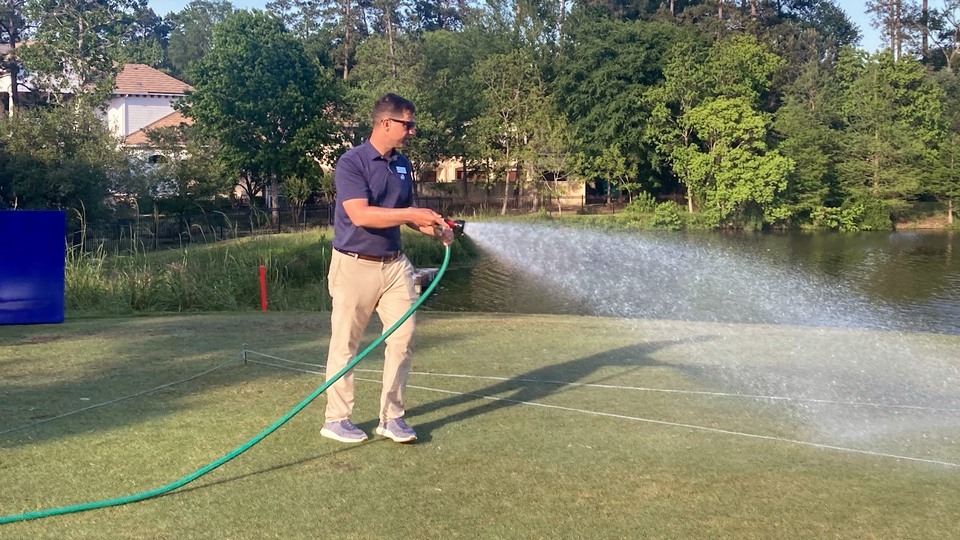What’s the biggest question in golf today? For some, how the existing split between the PGA Tour and LIV Golf will get resolved? Important yes – critical no.
For others, can Rory McIlroy end a 10+ years major-less streak with a win in April’s Masters and thereby become just the 6th member of the career Grand Slam Club. Yes, an important question but not the most paramount.
For some, can Tiger Woods regain his competitive form given the most recent surgery and win again thereby breaking the existing tie for career PGA Tour wins with Sam Snead? Undoubtedly, a topic of interest but not one with overall far-reaching consequences.
The most vexing challenge facing golf globally comes down to one word — water.
Among the most recent comprehensive reporting comes from the new Economic Impact Study, commissioned by the America Golf Industry Coalition and conducted by the National Golf Foundation.

What did it show?
The direct impact of golf in all aspects on the U.S. economy is roughly $102 billion. The total amount when calculating the sport’s indirect and secondary impacts pushes the total to over $226 billion. The sport also creates over 1.65 million jobs, including more than one million directly tied to the industry.
On the face of such numbers, the scope of the impact is impressive. However, sustaining those gains presumes the continuation of the most precious of natural resources — water. But clear challenges are emerging now and will likely only grow casting doubt that past progress is likely to continue on a steady positive pathway.
Golf courses, unlike other athletic fields of endeavor, are totally dependent on a highly prepared outdoor playing arena. Unquestionably, turf preparation has dramatically improved over the years. And those involved with the effort are better educated and have more tools at their disposal in order to create optimum playing conditions.
No golf course exemplifies the appearance of near perfection more than Augusta National Golf Club – the host site for next month’s annual Masters tournament. The deepest of pockets see fit to make sure each and every blade of grass is prepared to a level that is the envy of all globally. What is often unsaid is the sheer dollars spent and manhours given in order to create such a glorious Shangri-La.
The figurative blood for any golf course is the water used to keep the turf alive. But the overall competition for that water usage is only likely to increase in the years ahead. The thirst never ends and how much will be available for future usages is now prompting plenty of difficult questions to answer.
Audubon International estimates golf course uses roughly 312,000 gallons of water — each day. When all the golf courses in the U.S. are added together – nearly 17,000 — the sum total of that water usage equates to nearly 2.1 billion gallons of water. Keep in mind, the overall total water usage used on an estimated basis in the U.S. comes to just over 410 billions of gallons. The golf portion is roughly 1.3% used for irrigation purposes.
On the face of that the percentage of water for golf courses is quite small. However, as climate change has grown as an issue of critical importance, in tandem with the consequences of annual droughts intensifying, the spotlight on where water savings can be had is now becoming more and more noted.
Golf has always been an easy piñata for others to assail. The game’s earliest roots came from a time where those in the privileged leisure class had ample dollars to separate themselves from the masses. The bourgeoisie, and not the proletariat, were golf’s roots in the U.S.
The sport has clearly grown — courtesy of a growing middle class and spurred on by a dashing Arnold Palmer on television — the total U.S. figure is roughly 27 million on-course golfers. A post pandemic surge induced others to pick up the sport – predominantly women and those in the minority communities.
Nonetheless, the environmental community has long viewed golf as a wasteful activity. Siphoning off critical water supplies simply so that those with deeper pockets can play on a manicured field overly manipulated to get a desired result.
But there’s a counter point that often gets far little attention.
Water usage for golf courses has been reduced by 29% since 2005.
Organized groups such as the Golf Course Superintendents Association of America (GCSAA) have been leading the effort in expanding educational opportunities for members and in raising the bar of understanding for those who don’t comprehend the range of steps being undertaken.
Nonetheless, zealots on the environmental side keep the drum beating citing golf as a profligate waster of water. It’s been relatively easy connecting the dots and building public support that golf courses are insensitive and wasteful. Golf courses are ubiquitous throughout the U.S. and the visual aspect is generally solidified when people routinely pass by in their cars and see water flowing from sprinklers used for a playground that serves only a tiny percentage of participants.
When water restrictions extend to the broader general public the elevation of resentment is quite easy to stir. In a game of sheer numbers – golfers are just a fraction of the total population.
Realizing the need to stem the lopsided nature of information the United States Golf Association (USGA) has just released its Water Conservation Playbook – a comprehensive effort to provide courses with the latest tools and techniques to more effectively manage water utilization.
The digital publication, usga.org/water, written by the USGA with twelve contributing experts, is a noteworthy tangible result of the Association’s 15-year $30 million investment to help golf courses reduce overall water usage via its Green Section’s department.
“Golf is currently in a time of great growth, but the threat of water availability, and cost, combined with the changing weather patterns, poses long-term threats to our playing fields,” said Mike Whan, CEO of the USGA. “We want to put the best intelligence into the hands of those who are making decisions and working on courses every day, and spur innovation toward a more sustainable game.”
The ongoing debate is one that will clearly not end. Shaping that discussion is central to what the likely outcomes will be in terms of future water usage and amounts allocated.
“The non-golfing public generally feels that golf courses are bad for the environment, and they fail to realize the tremendous benefits they bring to the environment,” said Dr. J. Bryan Unruh, the 2023 GCSAA’s recipient of the President’s Award for Environmental Stewardship. “Especially (in) the urban environment that is often denuded of natural resources and covered with impervious surfaces.”
But Dr. Unruh states emphatically the needed goal in breaking down erroneous viewpoints that too often have shaped the debate on water usage.
“(T)hese same people may have an interest in “protecting the environment” or “conserving water or habitat” or “protecting pollinators” and they are often targeted with “anti-golf” campaigns filled with misinformation. As such, the golf course management industry has the daunting task of helping the disconnected “unlearn” misinformation.”
The ongoing effort will be a constant one — with increasing water limits likely and the prospect of added governmental involvement a near certainty. Water rights are not only the domain of arid States in the western region of the U.S., but now a yearly item of concern across a far broader and deeper landscape.
Climate change has exacerbated the equilibrium. Droughts are now happening more frequently with even higher temperatures which only add more stress for grass growth. The pressure on superintendents – the men and women on the front lines – is certainly rising to deal with an ever-increasing workload.
“Our facility has been adjusting to water restrictions for many years,” said Roby Robertson, Director for Golf Course Maintenance Operations for TPC San Antono in San Antonio, Texas – an annual stop on the PGA Tour.
“We are currently operating at 35-40% reduction due to drought, If we had to move to 50%, I think we would have to adjust our overall amount of irrigated turf, that is already at a set limit. Implications would lead to less overseeding, more natural grass area and probably less landscaping.”
Will golf remain in the crosshairs of the environmental community? Dialogues already exist but the nature of climate change and the strain on providing water usage to a growing global population will likely keep relationships tense.
“It is critical to the long-term sustainability of the game that golf demonstrates its commitment to the responsible use of resources,” said Rhett Evans, CEO of the GCSAA. “The USGA’s playbook is a great tool that provides our members effective, practical solutions to conserve water through best management practices.”
Golf has used its limited microphone to date in itemizing steps being taken. However, the amplifiers for others, often not keen to the interest of the sport, are much louder and are resonating more effectively at the moment.
Can meaningful common ground be found?
What’s abundantly clear is the ride ahead for golf is a likely roadway with any number of uncertain twists, turns and pot holes. Sustaining golf in close collaboration with science is the only pathway for ultimate promise.
Water is now the oil of the 21st century. The stakes are that high.
Fasten your seatbelts.
Images courtesy of the GCSAA.




